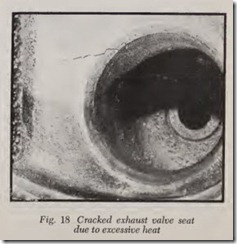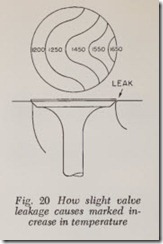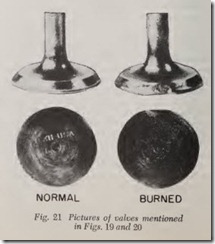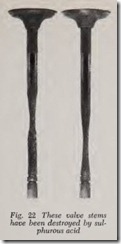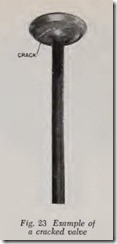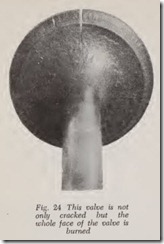VALVE TEMPERATURE
Most valve troubles are directly or indirectly caused by the high temperatures to which they are exposed. This is true even thou gh the valve mechani sm is mechanically perf ect. High tem peratures make it difficult to maint ain mechanical perfection for long. And if the valve system is less than mechanically perfect to begin with, the heat hastens the development of valve ailments.
HOT VA LVE SEATS
Distortion of either a valve or its seat changes it from the desired circular shape to an oval one, and if the distortion is mu ch m ore than .001″, leakage must result.
The distortion of the valve seat may be due to improper tightening of the cylinder head. If some cylinder head bolts are too tight and others too loose, the metal surrounding the seats may be pulled out of shape and thus the seat becomes oval instead of circular; or the seat may be tilted so that it is no longer at right angles to the guide. These troubles may occur with either L-head or overhead valve engines if the cylinder head bolts are not tightened carefully with a torqu e wrench as specified by the car maker.
Metals expand as they are heated. If the seat were a ring which was free from the head or block it would expand equally in all directions and thus remain circular. However, the seat is an integral part of the cylinder block or head and the casting may not permit circular expansion of the seat. Thus the seat may become oval and leakage will result.
Under normal operating conditions the seat will not depart from its circular shape sufficiently to cause leakage, but serious seat distortion and leakage may occur if the seat temperature be comes considerably higher than its normal maxi mum operating temperature.
Any defect in the cooling system which reduces its ability to remove heat from the seats may result in overheated seats. These defects include low water, clogged radiator or any other clogged pas sages, dirty radiator inside or out, loose fan belt. But probably the most serious of all is mineral deposits in the water passages surrounding the valve seats, Fig. 17. These deposits insulate the valve seats from the water and thus prevent proper cooling of the seats with the result that seat temperature rises and thus excessive distor tion and leakage may occur. In extreme cases, the temperature may be sufficient to crack the casting at the valve seat, Fig. 18.
An extremely hot exhaust valve seat may distort the adjacent intake valve seat sufficiently to cause leakage, because of flow of heat from the exhaust seat to the intake seat.
Excessively hot exhaust valve seats may be due to a lean mixture which burns so slowly that it is still very hot when the exhaust valve opens.
HOT VALVES
Fig. 19 is a diagram of the head of an exhaust valve at normal operating temperature. The tem perature is highest at the center ( 1350 degrees) and gradually decreases to 1200 degrees at the outside edge. This is to be expected because the face of the valve is in contact with the compara tively cool seat two-thirds of the time. Remember that the entire head of the valve is exposed to the high temperature of the combustion gases which may exceed 4000 degrees.
The valve head is hottest at its center but is even hotter near the upper end of the valve stem because the hot exhaust gases which How past this point when the valve is open cause the absorption of additional heat, raising the temperature beyond 1350 degrees.
Now let us assume that something causes this valve to leak very slightly. It could be a distorted seat or valve head or a s all piece of dirt between the valve face and the seat. Or perhaps the face of the valve has acquired a smooth, even coating of carbon or iron oxide. The coating does not cause leakage but eventually a piece of the coating breaks off and leakage occurs through this small channel. But, regardless of how the leakage starts, the leakage of 4000 degree combustion gases soon raises the temperature of the valve at the leakage point by several hundred degrees.
Fig. 20 shows the temperature diagram for the head of this slightly leaking valve. At the point of leakage the temperature has risen to 1605 degrees while the opposite side of the valve is a normal 1200 degrees because of its perfect contact with the cool seat. The two pairs of pictures in Fig. 21 show what happens to a normal exhaust valve when it starts to leak.
If the initial valve leakage is caused by a dis torted seat, a burned spot would soon appear provided the valve did not rotate. But many valves rotate slightly, in which case the whole face of the valve would eventually be roughened by slight burning.
Note also that when a valve is overheated at one point, as in Fig. 20, the elevated temperature expands the valve head outw ard so that the hot edge of the valve is eccentric to the valve guide and, theref ore, when expansion is sufficient, the valve seats at the h ot point but nowhere else. When this happens, the valve is well on its way to ruin.
Deposits which m ay become attached to the valve face and somet imes also to the valve seat include road dust, carbon from charred oil or fuel, iron oxide formed on the valve face by the hot exhaust gases lead compounds from Ethyl fluid. And all of these compounds may be firmly at tached to the hot valve face by gummy particles of oil. The heat bakes th e mixture to a hard, solid film.
Valve face and seat may be corroded by the hot exhaust gases which eat the metal away, often forming small indentations called pits. In some cases, the chemical reaction between the metal and the hot gases may produce small particles of iron carbide on valve face or seat. The iron car bide is chemically attached to th e surface. It is extremely hard-harder than a file. These particles cause valve leakage. They are so hard that they are difficult to remove when the valve and seat are ground.
When an exhaust valve develops a leak, for any of the reasons mentioned, its temperature may rise so high that not only is hot corrosion invited but also the temperature may be high enough to weaken the valve. The strength of all metals is reduced as the temperatur e rises. Special alloy steels are used for exhaust valves because these steels retain their strength at high temperature better than do ordinary carbon steels. But even these steels weaken when the temperature is high enough. A valve steel at 2000 degrees may be only 60 to 80 per cent as strong as it is at room temperature; and it is quite common for a valve to reach 2000 degrees or more if the car is driven hard when a valve is leaking.
The more the valve leaks, the hotter it gets. Here it should be remembered that a leaking valve is exposed to the extreme temperatures of the combustion gases sweeping through the leak age path. All this heat is in addition to that contributed by the exhaust gases which flow past the valve after it opens. No wonder the valve burns and sometimes melts with all this extra heat to contend with.
When leakage causes an exhaust valve to reach a temperature of about 2000 degrees at the center of the head or near the joint between the upper end of the stem and the head, the weakening may cause the valve to warp. The warpage may be caused by any factor which permits the valve to strike the scat at one particular point , thus placing a heavy bending stress on both the valve head and the upper stem.
The point of contact may be due to a distorted seat, dirt at one point of the valve face or seat or to any of the mechanical difficulties illustrated in the preceding pictures.
Any of the factors just mentioned will gradually bend the head of an overheated valve whose metal has been weakened by an elevated tempera ture. The bending or warping of the head does not occur all at once but gradually-under the repeated impact of hundreds or even thousands of blows. Hot metal “creeps” and thus the head is gradually distorted.
An extra hot upper stem will also creep, slowly but surely, because of the continuous downward pressure of the valve spring. Thus the stems of overheated valves are likely to beeome longer and may even stretch enough to reduce the tappet clearance to zero.
When an exhaust valve leaks and the engine is driven hard, the high temperature gases of com bustion may overheat the seat, causing burning or pitting and the expansion of the hot metal in the vicinity of the seat may craek the bloek. Burning of the seat and eraeking are both more likely to occur if the water passages surrounding th e seat are coated with mineral deposits which prevent free Bow of heat from th e hot seat to the cooling water. The same troubles are very likely to oecur if th e engine is driven hard when th e water level in the cooling system is so low that no water reaches the water pa ssages surrounding the valve seats.
SLUGGISH VA LVE CLOSING
N ext to leakage, sluggish valve closing is the most important eause of valve trouble and it may lead to outright leakage. As previously mentioned, valve leak age and retarded valve closing are the two major valve troubles. A weak or broken spring delays valve closing progressively as engine speed increases.
With prompt or normal valve closing, the valve spring presses on the valve and the valve presses on the tappet. Thus the valve spring forees the tappet against the “closing flank” of the eam. Therefore valve closing closely follows the cam motion.
Extra friction between valve stem and guide may slow down the closing of the valve so that it closes some time after the flank of the cam has moved out of the way.
Retarded intake valve closing causes a reduction in power because some of the mixture in the cylinder is pushed back out into the intake mani fold when the piston moves upward on its com pression stroke.
Retarded exhaust valve elosing also results in loss of power beeause the valve is open while the intake valve is open on the intake stroke of the piston. Thus the piston draws exhaust gas into the cylinder as well as mixture. The greater the per centage of exhaust gas in the mixture the greater the reduction in power.
Delayed exhaust valve closing inereases the valve temperature above normal beeause the interval that the valve is in eontact with its eool seat is appreciably redueed, and because the ex posure to hot exhaust gases is correspondingly increased.
Retarded valve closing, as mentioned above, may be due to a weak or broken spring. It may also be due to excessive frietion between valve stem and guide; or between the tappet and its guide, or both.
Extra friction between valve stem and guide is due to various eauses. In the ease of intake valves the most frequent cause is a gradual aeeumulation of gummy gasoline on the valve stem and guide surfaces. All gasolines contain some gummy sub stances. In the bett er grade gasolines the gum content is held to sueh a small fraction of a percent that the quantity of gum is not sufficient to cause sticking valves. However, even the most carefully refined gasolincs are subjeet to a gradually increasing gum content while in storage. The gum formation is due to a chemieal change in some of the ingredients in the fuel. Renee, if it should happen that the gasoline is stored for a long time before it is used, gummy valves may result.
The air in the valve chamber contains small particles of oil. Some of this oil eoats the valve stem and valve guide. In the case of exhaust valves, the stems may be at such high temperature that the oil is soon charred to form hard carbon on stem and guide surfaees. Thus the clearanee is slowly reduced and the time may arrive when the fit is so tight that valve closing is retarded. Serious carbon formation is unlikely as long as the valve stem guid e clearance is normal. But if the clear ance is excessive, m ore oil reaches the clearance space and, of course, valves with loose guides are not likely to seat properly and therefore their stems will b e abnormally hot. These two factors encourage th e formation of carbon on stem and guid e. In fact, some authorities state flatly that a deposit of carbon on valve stem and guide are proof of undu e wear.
Not e that high oil consumption results in oil particles in the exhaust. These particles may be come bak ed to the exhaust valve stem.
There are other causes of retarded valve clos ing. Too little guide clearance may slow down valve closing . This is only likely to happen when new valves an d guides have been installed or when the old guides have been reamed out and valves with over size stems installed with too little clearance. Obviously a valve with a bent stem can stick. The bend may be due to stem warpage or to dropping the valve.
When exhaust valves leak badly, the upper ends of the guides are exposed to the high temperature of the gases of combustion. Sometimes they be come so overh eated that they warp or even melt at the upp er end. Either of these conditions may cause valve sticking.
R etard ed valve closing may be due to too tight a fit betw een valve lifters and their guides or to gummy oil on the lifter and guide surfaces.
It should be realized that retarded valve closing may r ange all the way from a very slight delay up to complete stoppage of the valve before it reaches its seat. The amount of retardation in creases as time goes on.
A moderate degree of sluggishness in the clos ing of either intake or exhaust valves will cause rough idling. With increased retardation of clos ing some reduction of power may be noted. If an intake valve definitely sticks open, back-firing through the carburetor will occur whenever the valve sticks. If an exhaust valve sticks open more than just a little, the cylinder will misfire. Definite sticking of either an intake valve or exhaust valve will produce a noticeable click caused by the valve lifter banging against the valve stem.
Retarded valve closing may be intermittent. The valve may close normally after one opening and close slowly on the next. The same is true of outright valve sticking. A valve may stick open for one or more revolutions of the camshaft but it may be jarred loose sooner or later by the con tinual banging of the valve lifter against the stem.
Slow valve closing may be due to a weak or broken valve spring.
Fig. 22 shows a pair of valves whose stems have been eaten away by sulphurous acid. If there is more than a trace of sulphur in the fuel or oil, sulphur dioxide is formed. When this compound is dissolved in water it becomes sulphurous acid. The formation of this acid is encouraged by in adequate crankcase ventilation, humid air and low crankcase oil temperature. Valves which have failed because of excessive temperatures are shown in Figs. 23 and 24.

